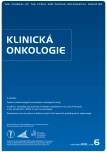Recommendation for preventive and therapeutic skin care of patients undergoing radiotherapy
Authors:
J. Cvek 1; S. Vokurka 2; E. Hajnová Fukasová 1; L. Krupová 3; P. Šimonová 1; M. Žemličková 4; M. Jedličková 5; K. Jirsová 6; P. Šlampa 7; M. Doležel 8; L. Hynková 9
Authors‘ workplace:
Klinika onkologická LF OU a FN Ostrava
1; Onkologická a radioterapeutická klinika LF UK v Plzni a FN Plzeň
2; Kožní oddělení, FN Ostrava
3; Dermatovenerologická klinika 1. LF UK a VFN v Praze
4; I. dermatovenerologická klinika FN u sv. Anny v Brně
5; Integrované onkologické centrum Nemocnice Na Pleši, Nová Ves pod Pleší
6; Klinika radiační onkologie LF MU a MOÚ Brno
7; Onkologická klinika LF UP a FN Olomouc
8; Klinika radiační onkologie LF MU a MOÚ Brno
9
Published in:
Klin Onkol 2021; 34(6): 481-487
Category:
doi:
https://doi.org/10.48095/ccko2021481
Overview
Background: Radiation dermatitis is a very common reaction to radiotherapy, affecting approx. 95% of patients with varying intensity. It is crucial to minimize its side effects. The working group that prepared this document includes physicians, nurses, representatives of the Society for Radiation Oncology, Biology and Physics of the Czech Medical Association of J. E. Purkyně, the Supportive Treatment and Care Section of the Czech Society for Oncology of the Czech Medical Association of J. E. Purkyně, the Czech Wound Management Association, the Oncological Section of Czech Association of Nurses, and dermatologists. The document has been approved by the committees of these associations. Purpose: Recommendation for preventive and therapeutic skin care of patients undergoing radiotherapy in the Czech Republic.
Keywords:
prevention – guideline – radiodermatitis – skin care
Sources
1. Šáteková L. Vybrané kapitoly z ošetřovatelství v onkologii. Olomouc: Univerzita Palackého v Olomouci 2019. doi: 10.5507/fzv.19.24456300.
2. Bryant AK, Banegas MP, Martinez ME et al. Trends in radiation therapy among cancer survivors in the United States, 2000–2030. Cancer Epidemiol Biomarkers Prev 2017; 26 (6): 963–970. doi: 10.1158/1055-9965.EPI-16-1023.
3. National Cancer Institute. Common terminology criteria for adverse events (CTCAE). [online]. Available from: https: //ctep.cancer.gov/protocolDevelopment/electronic_applications/ctc.htm.
4. Cox JD, Stetz JA, Pajak TF. Toxicity criteria of the Radiation Therapy Oncology Group (RTOG) and the European organization for research and treatment of cancer (EORTC). Int J Radiat Oncol Biol Phys 1995; 31 (5): 1341–1346. doi: 10.1016/0360-3016 (95) 00060-C.
5. Fitzpatrick TB. The Validity and practicality of sun-reactive skin types I through VI. Arch Dermatol 1988; 124 (6): 869–871. doi: 10.1001/archderm.124.6.869.
6. Iacovelli NA, Torrente Y, Ciuffreda A et al. Topical treatment of radiation-induced dermatitis: current issues and potential solutions. Drugs Context 2020; 9: 4–7. doi: 10.7573/dic.2020-4-7.
7. Šlampa P et al. Radiační onkologie. [v tisku]. Praha: Maxdorf 2021.
8. Bolderston A, Cashell A, McQuestion M et al. A Canadian survey of the management of radiation-induced skin reactions. J Med Imaging Radiat Sci 2018; 49 (2): 164–172. doi: 10.1016/j.jmir.2018.01.003.
9. Gee A, Moffitt D, Churn M et al. A randomized controlled trial to test a non-metallic deodorant used during a course of radiotherapy. J Radiother Pract 2000; 1 (4): 205–212. doi: 10.1017/S1460396999000321.
10. Chan RJ, Blades R, Jones L et al. A single-blind, randomised controlled trial of StrataXRT® – a silicone-based film-forming gel dressing for prophylaxis and management of radiation dermatitis in patients with head and neck cancer. Radiother Oncol 2019; 139: 72–78. doi: 10.1016/j.radonc.2019.07.014.
11. Herst PM, Bennett NC, Sutherland AE et al. Prophylactic use of Mepitel Film prevents radiation-induced moist desquamation in an intra-patient randomised controlled clinical trial of 78 breast cancer patients. Radiother Oncol 2014; 110 (1): 137–143. doi: 10.1016/j.radonc.2014.01. 005.
12. Møller PK, Olling K, Berg M et al. Breast cancer patients report reduced sensitivity and pain using a barrier film during radiotherapy – a Danish intra-patient randomized multicentre study. Tech Innov Patient Support Radiat Oncol 2018; 7: 20–25. doi: 10.1016/j.tipsro.2018.05.004.
13. Žemličková M. Poradiační poškození kůže, prevence a léčba. Podpůrná léčba 2019; 1 (4): 5–8.
14. Lam ACL, Yu E, Vanwynsberghe D et al. Phase III randomized pair comparison of a Barrier Film vs. standard skin care in preventing radiation dermatitis in post--lumpectomy patients with breast cancer receiving adjuvant radiation therapy. Cureus 2019; 11 (6): e4807. doi: 10.7759/cureus.4807.
15. Shaw S-Z, Nien H-H, Wu C-J et al. 3M Cavilon No-Sting Barrier Film or topical corticosteroid (mometasone furoate) for protection against radiation dermatitis: a clinical trial. J Formosan Med Assoc 2015; 114 (5): 407–414. doi: 10.1016/j.jfma.2013.04.003.
16. Stryja J, Krawczyk P, Hájek M et al. Repetitorium hojení ran. Semily: GEUM 2016.
17. Vorlíček J, Abrahámová J, Vorlíčková H. Klinická onkologie pro sestry. Praha: Grada 2012.
18. Johnson K, Fenton G, White RJ. Radiation dermatitis: the evaluation of a new topical therapy for the treatment and prevention of radiation-induced skin damage and moist desquamation: a multicentre UK case cohort study. J Radiother Pract 2021; 1–5. doi: 10.1017/S1460396920001077.
19. Barnea Y, Weiss J, Gur E. A review of the applications of the hydrofiber dressing with silver (Aquacel Ag) in wound care. Ther Clin Risk Manag 2010; 6: 21–27.
20. Paterson D, Poonam P, Bennett NC et al. Randomized intra-patient controlled trial of mepilex lite dressings versus aqueous cream in managing radiation-induced skin reactions postmastectomy. J Cancer Sci Ther 2012; 4 (11): 347–356. doi: 10.4172/1948-5956.1000166.
21. Suresh R, Raffi J, Yuen F et al. Treatment of moist desquamation for patients undergoing radiotherapy. Int J Womens Dermatol 2019; 5 (2): 124–125. doi: 10.1016/j.ijwd.2018.12.002.
Labels
Paediatric clinical oncology Surgery Clinical oncologyArticle was published in
Clinical Oncology

2021 Issue 6
- Metamizole vs. Tramadol in Postoperative Analgesia
- Metamizole at a Glance and in Practice – Effective Non-Opioid Analgesic for All Ages
- The Importance of Hydration in Wound Healing
- Obstacle Called Vasospasm: Which Solution Is Most Effective in Microsurgery and How to Pharmacologically Assist It?
- Possibilities of Using Metamizole in the Treatment of Acute Primary Headaches
Most read in this issue
- Waldenström macroglobulinemia
- Erdheim-Chester disease
- Recommendation for preventive and therapeutic skin care of patients undergoing radiotherapy
- Advanced stages of classical Hodgkin lymphoma – first-line treatment options
